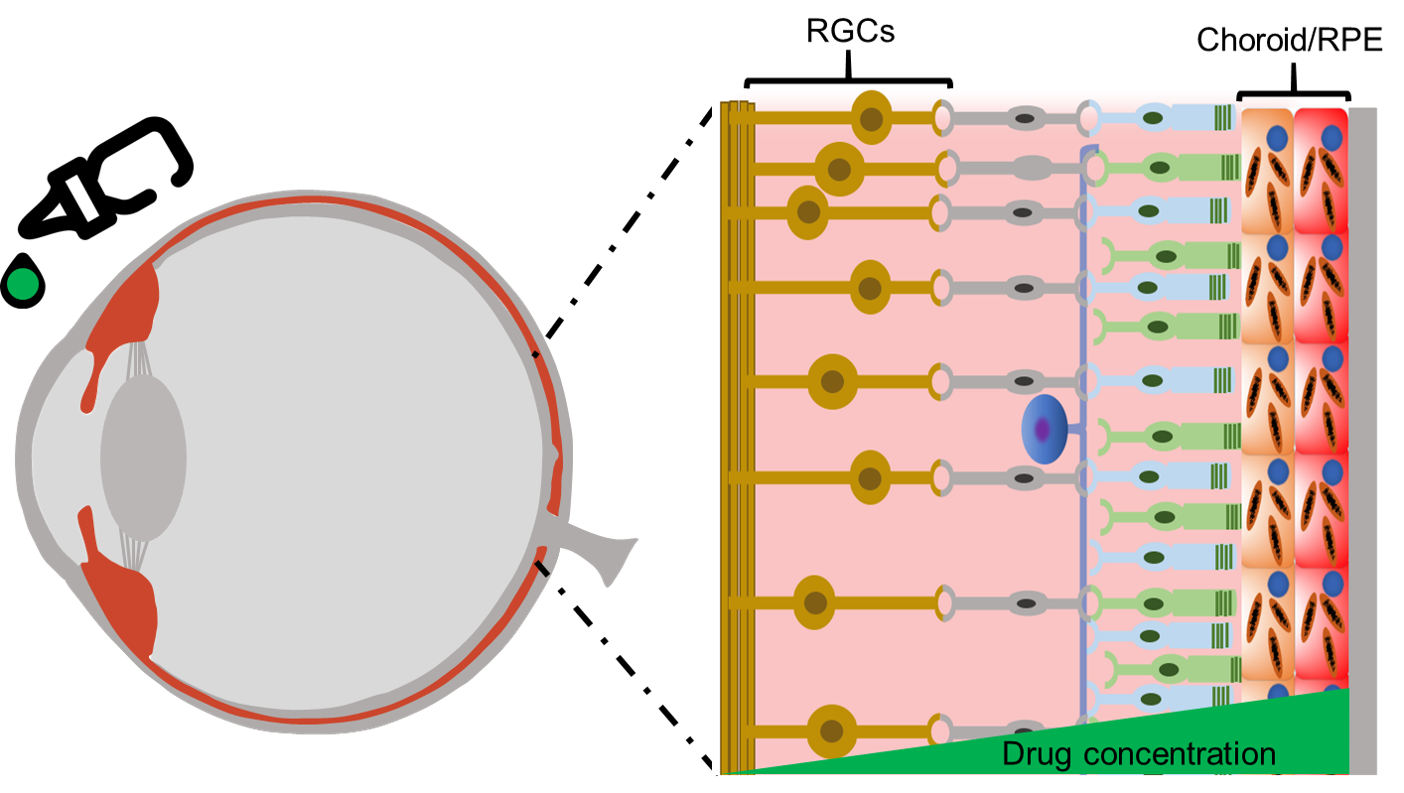Article
Controlling glaucoma: Eye drop therapy reaches posterior ocular tissues
Author(s):
A novel eye drop under development may provide neuroprotection to the retinal ganglion cells.
The path that eye drops take to reach posterior ocular tissues of the eye.
(Image courtesy of Laura Ensign, PhD)

A novel eye drop under development may provide neuroprotection to the retinal ganglion cells (RGCs). An added plus is that only once-weekly dosing is required, according to Laura Ensign, PhD, who headed up the research.
Ensign holds the Marcella E. Woll Professorship in Ophthalmology and is an associate professor of ophthalmology and vice chair for research at the Wilmer Eye Institute, Johns Hopkins Medicine in Baltimore, Maryland. This work is being conducted in collaboration with Justin Hanes, PhD, who is the Lewis J. Ort Professor of Ophthalmology and director of the Center for Nanomedicine at the Johns Hopkins University School of Medicine, and Donald Zack, MD, PhD, the Guerrieri Professor of Genetic Engineering and Molecular Ophthalmology and codirector of the Center for Stem Cells and Ocular Regenerative Medicine at the Wilmer Eye Institute.
Antiglaucoma eye drops are the mainstay of treatment for the disease, and they successfully and significantly lower the IOP. However, despite achieving a reduction of the IOP, glaucoma can continue to progress and threaten vision in many patients diagnosed with the disease. A therapy that protects the RGCs from damage was just a dream until recently. This new therapy developed by the Wilmer Eye Institute team is in the process of becoming a reality.
“The concept of delivering a drug to protect RGCs is not something that is currently done clinically, but as a complement to IOP lowering, may be an important glaucoma management tool,” Ensign said. “The fact that we can potentially protect the RGCs using an eye drop is unique and interesting, because this route is not typically used to deliver therapy to the retina.” The investigators reported their progress in Drug Delivery and Translational Research.
The innovation
The drug, sunitinib (Sutent, Pfizer), was delivered in a novel gel-forming eye drop that remains in place for an extended period and provides increased intraocular drug absorption. In combination with the intrinsic melanin-binding properties of sunitinib, drug binding in the pigmented cells in the choroid and retinal pigment epithelium provided sustained, therapeutically relevant drug concentrations in the retina to protect the RGCs. “The process of binding to melanin serves as a reservoir for the drug—ie, it is a built-in sustained delivery system in the ocular cells,” Ensign said.
The 2-fold advantages of this therapeutic pathway are clear: (1) transport of the drug to the back of the eye in sufficiently high therapeutic concentrations, and (2) the sustained release of the drug over time from melanin. This capability allowed for once-weekly dosing that continues to provide a therapeutic effect in the retina, which has the potential to decrease the patient treatment burden.
Moving the research along
Ensign and Hanes formed a start-up company under the umbrella of Johns Hopkins to develop the eye drop technology. The eye drop has not yet moved into clinical trials, but this is currently being considered. The ultimate goal is to have an eye drop available in a few years that is intended to treat retinal disease, according to Ensign.
In a previous publication,2 Ensign and colleagues in collaboration with Peter Campochiaro, MD, also from the Wilmer Eye Institute, used a porcine model to show that choroidal neovascularization was prevented by the sunitinib gel-forming eye drop in contrast to a saline eye drop version of the drug, which had no effect. “Our eye drop decreased the area of neovascularization by [approximately] half,” Ensign said.
The next step is to evaluate the effect of different doses of the sunitinib drop for glaucoma. In addition, for age-related macular degeneration, the investigators are considering a daily dose.
Laura Ensign, PhD
E: lensign@jhmi.edu
Ensign has a financial interest in this technology. She is one of the inventors listed on patents/patent applications related to this technology and is one of the cofounders of the start-up company planning to develop the eye drop technology for clinical use.
References
1. Kim YC, Hsueh HT, Shin MD, et al. A hypotonic gel-forming eye drop provides enhanced intraocular delivery of a kinase inhibitor with melanin-binding properties for sustained protection of retinal ganglion cells. Drug Deliv Transl Res. 2022;12(4):826-837. doi:10.1007/s13346-021-00987-6
2. Kim YC, Shin MD, Hackett SF, et al. Gelling hypotonic polymer solution for extended topical drug delivery to the eye. Nature Biomed Eng. 2020;4(11):1053-1062. doi:10.1038/s41551-020-00606-8
Newsletter
Don’t miss out—get Ophthalmology Times updates on the latest clinical advancements and expert interviews, straight to your inbox.




